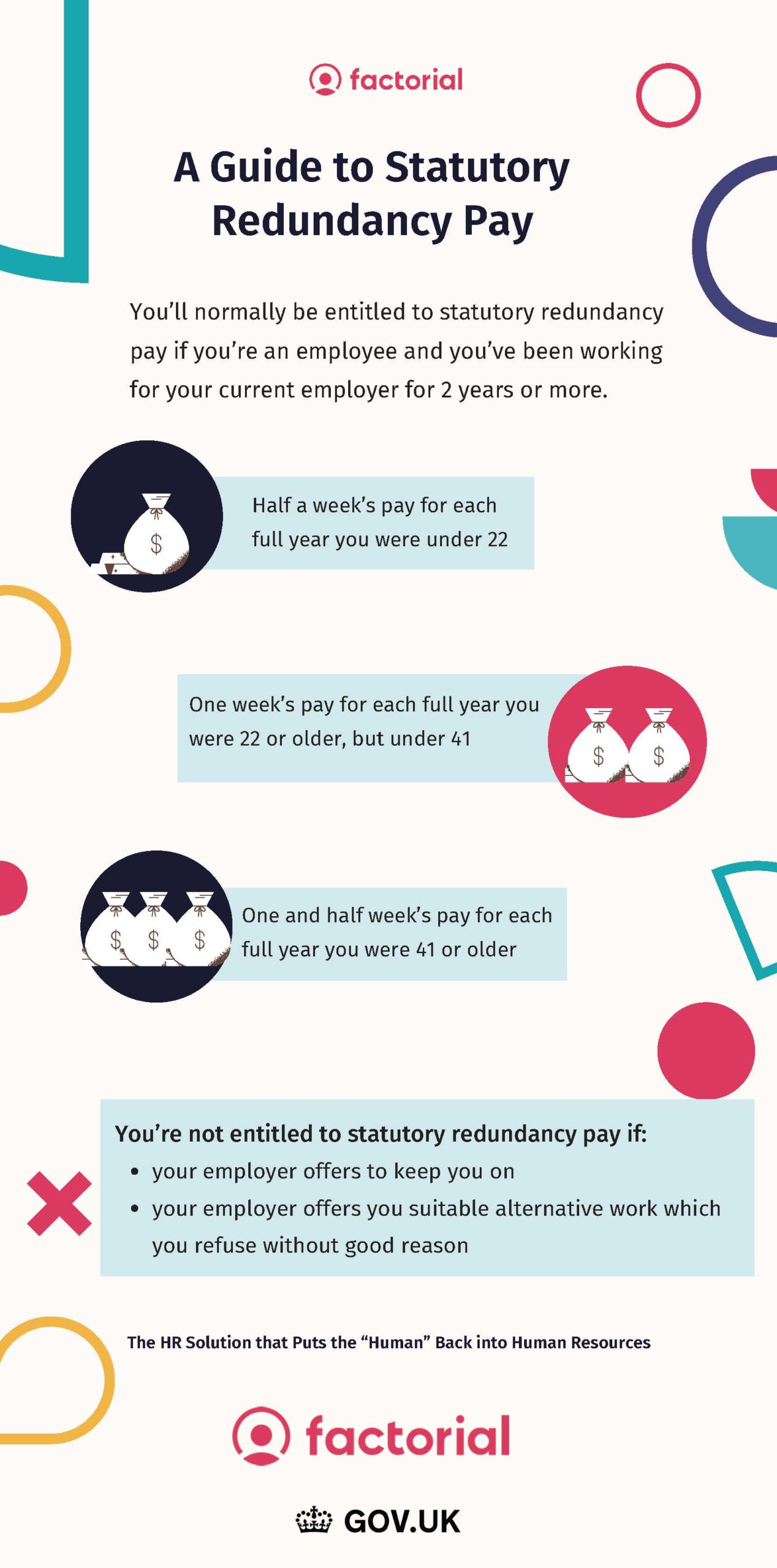Redundancy is a type of dismissal used when a role is no longer needed or no longer exists in an organisation. It can occur as companies restructure or reduce their workforce, or when technology solves the tasks to perform. But regardless of your reasons, companies must give redundancy pay when dismissing an employee.
Even when redundancy is not related to an employee’s performance, it’s important to make sure the reason for dismissal is acceptable and fair. Otherwise, your company could face legal claims relating to unfair dismissal.
In this post, we will discuss what’s considered a fair dismissal, and how it differs from severance pay. In addition, we provide guidelines so you can calculate it and identify whether your employees are entitled or not.
What is Statutory Redundancy Pay?
Redundancy occurs when organisations no longer need to cover a particular role.
The UK Law states that employers have to pay their employees a basic amount when they make them redundant. This minimum is called statutory redundancy pay. But you can choose to offer more than the minimum statutory redundancy pay if this fits with your company’s culture.
Average rate of Statutory Redundancy Pay in 2025
There is no average rate of statutory redundancy pay in 2025 because it is determined by the weekly wage someone earns, how old they are and how long they have been in continuous service.
Changes to the maximum weekly amount and total payment amounts are usually announced before they take effect in April. For 2025, no changes have been announced yet.
Who is Not Entitled to Redundancy Pay?
Redundancy pay is a right for employees who worked at least 2 years in the company. It is not intended to compensate employees who have been fired due to their misconduct, but to help those who lose their jobs as part of a company restructure or because their role is no longer necessary. Moreover, it doesn’t apply to employees who were forced to terminate their contracts early. In such cases, you need to provide severance pay.
Anyone who hasn’t worked long enough to qualify for statutory redundancy pay won’t be entitled to it. However, if you’re over 18 and have worked continuously for your employer for at least one month and less than two years, you might be eligible to claim a redundancy payment under the Employment Rights Act 1996.
Certain employees aren’t entitled to receive a redundancy payout, including staff members who worked for the company for less than 2 years and employees who accepted a suitable alternative position.
How Much is Statutory Redundancy Pay?
The minimum amount of redundancy pay will vary according to your employees’ length of service, weekly pay, and age. Still, for those employees who become redundant after April 6 2021, the weekly copped is £544, and the maximum statutory redundancy pay you must pay is £16,320.
The government states that entitled employees have the right to receive:
- Half a week’s pay for each full year the employee was under 22.
- One week’s pay for each full year the employee was between 22 and 41.
- One and half week’s pay for each full year the employee was 41 or older.
A Guide to Statutory Redundancy Pay [+ Infographic]
Understanding Statutory Redundancy Pay can be complicated, but we’ll break it down for you. Let’s review who’s eligible and who isn’t.
Who is eligible for Statutory Redundancy Pay?
First, it’s important to identify what characteristics an employee must have in order to qualify. They must adhere to the following:
- have a contract of employment
- worked for the company for two years
- been dismissed, laid off, or put on short-time working
- be a UK or EEA national or have the right to work in the UK
Who is not eligible for Statutory Redundancy Pay?
On the other hand, let’s review who is not eligible. The following characteristics would deem an employee unqualified:
- employees who have not worked at the company for two years
- employees who have been offered suitable alternative employment
- the self-employed or those on fixed-term contracts with a written agreement waiving redundancy pay
- people working in specific sectors or roles such as the armed forces, the police, apprentices who are not employees, and domestic servants working for close family members
How to Calculate Your Employees’ Redundancy Pay
Redundancy pay is calculated by multiplying the number of weeks of service by the statutory weekly amount.
You can calculate redundancy pay by using the Government online redundancy calculator.
How much do you receive in statutory redundancy pay?
How much you will receive in statutory redundancy pay depends on your weekly wage, your age, and the number of years of continuous service you have. You must receive:
- Half a week’s pay for each year you worked when you were between 17 and 21.
- One week’s pay for each year you worked when you were between 22 and 40.
- One and a half week’s pay for each year you worked when you were over 41.
The maximum weekly payment that can be made as part of statutory redundancy pay is £700, and the maximum total payment that can be made is £21000.
The number of years of continuous service is capped at 20.
To calculate your weekly rate, add up your earnings over the last 12 weeks and divide it by 12.
Calculate statutory redundancy pay example
The UK government have a tool to help you calculate statutory redundancy pay. You need to know their weekly rate, age and when they started continuous employment with you to calculate redundancy pay.
Here’s an example of an employer calculating their employee’s redundancy pay:
Jo is 43 and earns £500 per week. She has worked for the company for 24 years.
- Her statutory redundancy pay is capped at 20 years of service.
- As she is 43, she is entitled to two years’ worth of pay at one and a half weeks. This would be £1500.
- She is then eligible for 18 years’ worth of pay at her weekly rate. This amount is based on her service between the age of 23 and 41, and would be £9000.
- Even though Jo started working for the company when she was 19, but the 20-year cap means her service between the ages of 19 and 22 is irrelevant to her redundancy calculation.

Making Staff Redundant
Dismissal through redundancy is a potentially fair reason for dismissal. But an employer must demonstrate that it had a genuine need to reduce its workforce and that the dismissals were carried out fairly.
Before getting to the point of dismissing an employee, you must consider changing working hours and offering a different role inside the company.
Employers should also ensure that the affected staff members are involved in a consultation process and that a legal notice of termination is given. An employee who is asked to retire or resign for redundancy has the right to a written statement that sets out the amount of payment and how you worked out redundancy pay.
Voluntary Redundancy Pay
Voluntary redundancy pay is meant to compensate employees for loss of job security. It is a sum of money that the employer pays to the employee in exchange for leaving the company. Many companies use this payment as an incentive for employees to leave rather than fire them.
How Does It Work?
The company decides on a voluntary redundancy package, which it offers to employees who are willing to leave. The aim here is usually to reduce staff, avoiding compulsory redundancies, which are more expensive and riskier for the company.
Some companies plan a fixed number of positions that will be made redundant within a certain period (e.g., two months). The employer then offers voluntary redundancy packages to those who wish to leave and presents them with an option: either accept the voluntary redundancy package or risk being made compulsorily redundant later on.
Unfair and Constructive Dismissal
Unfair dismissals occur when an employee is fired from their job in a way that’s wrong, unjust or unreasonable. The employer must have a fair reason for the dismissal.
If your employees believe they have been unfairly dismissed from work, you may receive a claim. This process is called a constructive dismissal claim, and it’s different from firing for misconduct or a disciplinary reason.
The five potentially fair reasons for dismissing an employee are:
- Misconduct.
- Capability.
- Redundancy.
- Illegality; or
- Some other reason that directly affects your company and you can prove.
For a dismissal to be considered unfair, it must first be a dismissal as defined by the Fair Work Act 2009, and secondly satisfy one of the following criteria:
- The dismissal was harsh, unjust, or discriminatory.
- The person had not an opportunity to respond to the reasons given by the employer for dismissal.
- There was not a valid reason based on the need for the employer to restructure its workforce or business operations.
- There was not a “genuine redundancy”. When a person’s job no longer exists due to changes in workplace operation or technology, this is considered a legitimate redundancy.
Offering a Suitable Alternative Employment
If you need to dismiss an employee purely because they are redundant, you must also consider whether it may be possible to offer an alternative role inside your organisation.
When an employer refuses to offer an employee suitable alternative employment and dismisses them anyway, the dismissal can be found unfair, and the employee will be able to claim compensation for unfair dismissal (subject to qualifying criteria) even though they were in fact redundant.
Managing dismissal properly can be a challenge. Not only because you need to ensure law compliance, but also because changing the workforce dynamics can impact performance and productivity. To help you calculate redundancy pay and manage communication channels with ease, we built an all-in-one HR system you can use to simplify the process.

